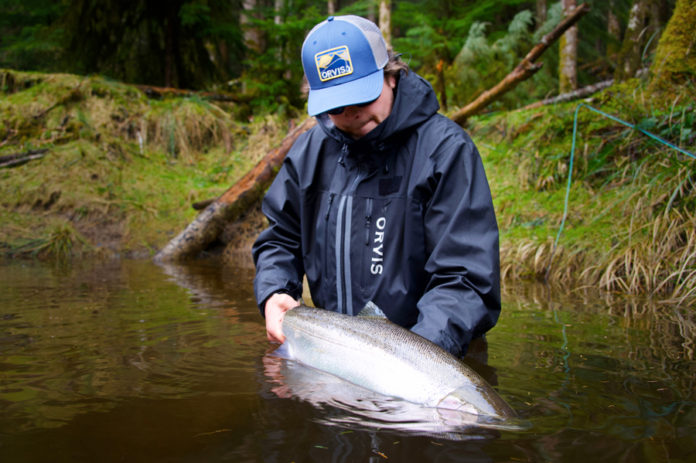Written by: Derek Botchford and Steve Morrow, Epic Waters Angling
Epic Waters Angling and Orvis have teamed up to create a steelheading miniseries. Using the latest Orvis prototypes, the clips are specifically catered to small-stream tactics. After a busy season of guiding, Derek Botchford and Steve Morrow set out to deliver viewers techniques that are designed to elevate the game of steelhead anglers from the west to the Great Lakes.
You know that incredible feeling when you lunch a monster cast across and downstream, almost clear to the opposite bank, and a fish eats a fly swinging across the top? Well, this is not that.
Small streams present their own set of challenges, and all runs are not uniform. Maybe more than most, creek lies require some preparation and planning and can present anglers with plenty of obstacles: branches overhead, logs in the way, tricky wading, concentrated flow, and tight quarters. You might think a smaller stream is going to be a piece of cake, but that would be a mistake.
So what to do?
1. Cast Short
Fishing your short cast is an important skill everywhere you find steelhead. I sound like a broken record when I guide: “Start with your sink tip.” Someone once asked me, “What is the most important piece of advice for beginners? How about advanced anglers?” My answer for both was the same: don’t forget the short game.
On creeks, short casts are important for several reasons. First, a big cast is more likely to hook obstructions or overhanging debris. Second, less line is easier to flop into every likely-looking spot as you pick your way downstream. Reeling in and starting again is a time killer. Plus, the more line you have out, the less control you have over your swing as it navigates the currents. Lastly, an eat just 12 feet away can be the kind of emotionally scarring event that will leave you hungry for years to come.
2. Pay Attention to Casting Angles
Determining the angle of the cast is vitally important to the depth of your presentation. While swings that are slower are generally better, more important in the creek game is depth. Even the weariest winter steelhead will move for the occasional offering, but there is usually a limit. Getting the fly within their window can be a challenge, but a necessary one. The easiest way to achieve depth is to cast across, or even slightly upstream, with a small mend and then allow the tip and fly a few seconds to sink. Then swing as you normally would. Typically a grab comes in the first few seconds of the sweep, as the fly starts swimming.

3. Work the Hangdown
The dangle accounts for astronomical number of hookups, while it has the distinction of being most hated steelhead tactic. Why the contradiction? Hangdowns are the least sexy part of any swing, really, requiring no skill other that patience. You need to ooze patience. You need so much patience it’s aggravating.
There’s a place we guide where steelhead rest on the hangdown under dynamic dueling currents. It’s the kind of spot where boredom makes you do it wrong. Anxiety takes over, and you find yourself rushing. You know you need to be patient, but you just can’t help yourself. The name of run is “the annoying hangdown.” If it’s not annoying, you’re doing it wrong.
Credit: Source link































